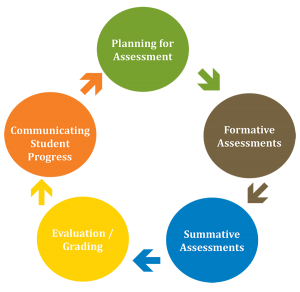
Principle #2
Assessment methods must be appropriate for and compatible with the purpose and context of the assessment.
“…aligning our assessments to our curriculum is the only way to ensure that our assessment yield accurate information about our students’ levels of proficiency. Knowing what we’re assessing should always drive our assessment methods. Balanced assessment isn’t about favouring one type of assessment; it’s about favouring the assessment method that is the most accurate fit for the curricular content or competency being assessed. This is especially true at the classroom level where we know assessment (and the subsequent descriptive feedback) can move learning forward, lead to greater student engagement, and allow teachers to make pinpoint decisions about what comes next. ”
—Tom Schimmer
How teachers assess student learning can have profound and lasting effects on their willingness, desire, and capacity to learn. As a result, assessments should be thoughtfully and intentionally planned, and measure student performance based on what students know, understand and do. Assessments must be linked to the curricular competencies and content, with a clear connection between criteria on the assessment and what has been taught in class. Students should be able to explain the relevance of a particular assessment based on its alignment with previous learning.
In order to ensure assessment is appropriate, compatible and well balanced, Wiggins and McTighe (2005) suggest teachers ask themselves the following questions:
- What would be sufficient and revealing evidence of understanding?
- What performance tasks should anchor the unit and focus the instructional work?
- What are the different types of evidence required?
- Against what criteria will we appropriately consider work and assess levels of quality?
- Will the assessment reveal and distinguish those who really understand from those who only seem to understand?
Throughout each unit of study, multiple assessment methods should be used, from traditional tests to authentic performance based assessments. A variety of assessments, including self-assessments and peer assessments, provide the teacher with a well-rounded picture, or photo album, of the students’ skills and learning of the essential outcomes.
ASSESSMENT CYCLE

TRY THIS
Click here for ideas to try in the classroom
1) Identify ways the skills/concepts are demonstrated in real life (authentic assessments).
2) Have students reflect on their progress and set goals for continued improvement in preparation for the summative assessment snapshot (self-assessment).
3) Use a variety of assessments when evaluating your students’ progress – portfolios, exit slips, peer/self-assessments, performances, compositions, oral presentations, tests.
4) Explore the elaborations in the BC curriculum for implementation and assessment ideas.
5) Identify the “ways of knowing” linked to the discipline/unit of study.
6) Ask yourself: Why am I giving this assessment?
7) Ask yourself: Who will use the assessment information and how will this information be used?
8) Read about GRASPS tasks on the Curriculum Hub for assistance with developing authentic performance tasks for students.
9) Develop and share assessment rubrics with your students.
WATCH THIS
Click here to watch related video content
Rick Wormeli on Standards-Based Grading
“Letter grades, rubric scores, percentages are nonsense symbols.” Rick Wormeli offers a different perspective on implementing grading in your classroom.
Assessment and Grading in the Differentiated Classroom with Rick Wormeli
Rick Wormeli, author of Fair Isn’t Always Equal, tackles the issue of zeros on the 100 point scale.
Standards-Based Grading Overview
An introduction to Standards-Based Grading by ActiveGrade.
What is Standards-Based Grading?
The 2011-12 Solon Community School District study states, “SCSD stakeholders will analyze and study aspects of standards-based grading and reporting at all grade levels.”
BC’s K-12 Assessment System
Assessment and curriculum are interconnected. Curriculum sets the learning standards that give focus to classroom instruction and assessment. Assessment involves the wide variety of methods or tools that educators use to identify student learning needs, measure competency acquisition, and evaluate students’ progress toward meeting provincial learning standards. Learn more.
READ THIS
Click here for additional reading suggestions
To learn more, check out these texts:
- Chappuis, J. & Chappuis, S. (2002). Understanding School Assessment. Assessment Training Institute, Portland, OR.
- Marzano, Robert J. (2006). Classroom Assessment & Grading that Work. ASCD, Alexandria, VA.
- Marzano, R. (1992). A different kind of classroom: Teaching with dimensions of learning. ASCD, Alexandria, VA.
- Moss, C.M, & Brookhart. S.M. (2012). Learning Targets, ASCD, Alexandria, VA.
- Stiggins, R.J., Arter, J.A., Chappuis, J. & Chappuis, S. (2004). Classroom Assessment for Student Learning – Doing It Right – Using It Well. Assessment Training Institute, Portland, OR.
- Wiggins, G. (1998). Educative assessment: Designing assessments to inform and improve student performance. Jossey-Bass, San Francisco, CA.
- Wiggins, G., & McTighe, J. (2005). Understanding by Design (expanded 2nd edition). Alexandria, VA: ASCD.
